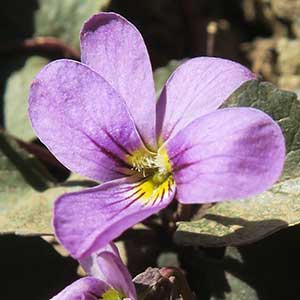Viola flettii
Viola charlestonensis
Flett's violet, Olympic violet, rock violet
Charleston Mountain or Charleston violet, Charleston Mountain violet
1–3, ascending to erect, mostly glabrous, on caudex from fleshy rhizome.
1–3, prostrate, decumbent, or erect, leafy proximally and distally, 1/2–2/3 subterranean, glabrous or puberulent, on caudex from usually vertical, subligneous rhizome.
basal and cauline;
basal: 1–3;
stipules linear-lanceolate, margins entire or with glandular processes, apex acuminate;
petiole 1.5–9.7 cm, mostly glabrous;
blade purple-tinted and –veined, broadly reniform to ovate, 0.9–2.4 × 1.2–4 cm, base cordate, margins finely crenate-serrate, eciliate, apex acute to obtuse, surfaces glabrous or sparsely pubescent along veins adaxially;
cauline similar to basal except: stipules ovate to lanceolate, margins entire or shallowly laciniate;
petiole 0.7–5.9 cm, usually glabrous;
blade 0.8–2.1 × 1.2–3.1 cm.
basal and cauline;
basal: 1–3;
stipules adnate to petiole, forming 2 linear-lanceolate wings, margins entire or sparingly lacerate, apex of each wing free, acuminate;
petiole 3.5–13.5 cm, densely short-puberulent;
blade purplish abaxially (often dark purple-veined), grayish adaxially with prominent whitish veins (from dense hairs), usually orbiculate to broadly ovate, sometimes reniform, thick, 1–3.5 × 1.1–3.3 cm, base attenuate or truncate, margins entire, ciliate mostly on proximal half of blade, apex acute to obtuse, mucronulate, surfaces densely short-puberulent;
cauline similar to basal except: stipules deltate to lanceolate, apex acute;
petiole 1.9–3.4 cm;
blade ovate or elliptic to deltate, 0.7–3.1 × 0.6–2.2 cm, length 0.7–1.9 times width, base usually attenuate, sometimes subcordate, margins entire, ciliate.
1.8–7.1 cm, usually glabrous.
1.7–6.6 cm, pubescent.
sepals lanceolate, margins eciliate, auricles 0.5–1.5 mm;
petals soft reddish violet on both surfaces, all with yellow area basally, lower 3 dark violet-veined, lateral 2 bearded, lowest with white around yellow area, 10–15 mm, spur yellow, gibbous, 0.5–2 mm;
style head bearded; cleistogamous flowers axillary.
sepals linear-lanceolate, margins ciliate or eciliate, auricles 0.5–1 mm;
petals deep lemon-yellow adaxially, upper 2 usually conspicuously reddish brown to brownish purple abaxially, lateral 2 streaked or solid reddish brown, lower 3 and sometimes upper 2 dark brown-veined proximally, lateral 2 bearded, lowest 8–13 mm, spur usually reddish brown, sometimes yellowish, gibbous, 0.4–2 mm, glabrous or scabrous abaxially;
style head bearded; cleistogamous flowers axillary.
± spherical, 5–9 mm, glabrous.
spherical, 4.5–9 mm, puberulent.
dark brown to brownish purple, 2.5–3 mm.
black, 3.4–3.5 mm.
= 12.
Viola flettii
Viola charlestonensis
Viola flettii is endemic to the Olympic Mountains of northwestern Washington. C. S. McCreary (2005) noted that although morphologically and ecologically distinct, V. cuneata, V. flettii, and V. ocellata are closely related.
(Discussion copyrighted by Flora of North America; reprinted with permission.)
Viola charlestonensis is known only from the Spring Mountains (previously called Charleston Mountains) in Nevada and Zion National Park, Utah. M. S. Baker (in I. W. Clokey 1945) stated that E. C. Jaeger reportedly collected it at Jacob’s Pool, Arizona, in July 1926. The location of this single Arizona collection may be an error (R. J. Little 2001).
M. S. Baker and J. Clausen (in I. W. Clokey 1945) stated that Viola charlestonensis is the only species in Becker’s Nuttallianae group with the spur pubescent on the exterior. In some populations in the Spring Mountains, Nevada, the spur and the midvein on the abaxial surface of the lowest petal to ± the middle of the lowest petal are covered ± densely with short hairs. Scattered hairs are also present on the abaxial surface of the lateral and upper petals. In other populations in the Spring Mountains, short hairs are mostly absent on the spur, lowest petal, and abaxial surfaces of lateral and upper petals.
M. S. Baker (in I. W. Clokey 1945) commented that he observed numerous sterile flowers and relatively few mature capsules and seeds of Viola charlestonensis plants when he visited the Spring Mountains in June 1937. Similar observations were made of V. charlestonensis plants in the Spring Mountains at one location in 2009 and of three other locations in 2010.
(Discussion copyrighted by Flora of North America; reprinted with permission.)


